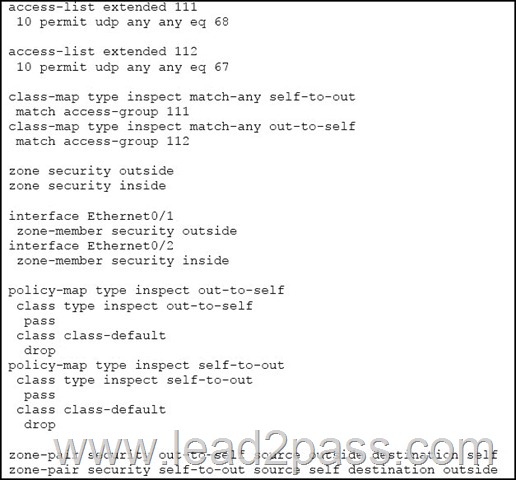2016 October Cisco Official New Released 400-101 Dumps in Lead2pass.com!
100% Free Download! 100% Pass Guaranteed!
Lead2pass is the best place for preparing IT exam as we are providing the latest and guaranteed questions for all certifications. We offer you the ultimate preparation resource of Cisco 400-101 exam questions and answers. Wondering what could be this effective? It is our Cisco 400-101 VCE and PDF which serves as a guide to pass Cisco 400-101 exam.
Following questions and answers are all new published by Cisco Official Exam Center: http://www.lead2pass.com/400-101.html
QUESTION 201
Refer to the exhibit. A network engineer is trying to configure a router as a zone-based firewall and needs to allow DHCP traffic to and from the router on the outside interface. After applying the configuration to the router, he notices that his configuration is not working.
What is wrong with the configuration?
A. The UDP ports in access list 111 and access list 112 are incorrect.
B. The wrong action has been configured on the policy map.
C. The zone pair configuration is incorrect.
D. The inside and outside references are incorrect.
Answer: A
QUESTION 202
Refer to the exhibit. The multicast sender and both multicast receivers are in the same VLAN. Multicast receiver 1 can receive the multicast stream from the multicast sender, but multicast receiver 2 cannot receive this stream. While troubleshooting IGMP, it is noticed that the IGMP report from receiver 2 is received by switch 2 but not by switch 1.
Which action will solve this issue? 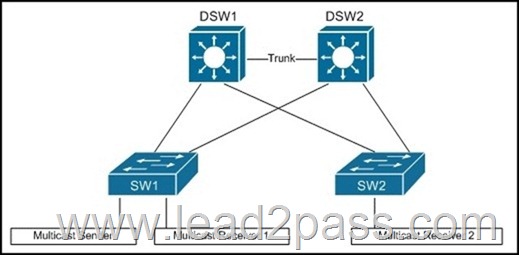
A. Enable PIM on the SVI of the VLAN on switch DSW1 or switch DSW2.
B. Add a straight connection between switch SW1 and switch SW2.
C. Enable IGMPv3 membership reports on multicast receiver 2.
D. Configure a rendezvous point on distribution switch DSW1 and distribution switch DSW2.
Answer: A
QUESTION 203
Refer to the exhibit. A network engineer enables a new port channel between two switches. Both switches are configured for spanning-tree MST. What is causing the dispute message to appear on one of the switches? 
A. The switch received an IEEE 802.1D BPDU on that port.
B. The BPDU that is received from the peer is inferior, with the designated role and state as learning
or forwarding.
C. The peer switch has been configured with a different VLAN instance mapping.
D. The switch has received a malformed BPDU.
Answer: B
QUESTION 204
Which two Cisco IOS features can be used to defend against spoofing attacks? (Choose two.)
A. auth-proxy
B. lock-and-key ACL
C. IP Source Guard
D. TCP Intercept
E. CAR
F. uRPF
G. reflexive ACL
Answer: CF
QUESTION 205
For which IP SLA test type is an IP SLA responder required on the target device?
A. Path-echo
B. Path-jitter
C. An IP SLA responder is not required for any of these probes.
D. Udp-echo
E. Tcp-connect
F. HTTP
Answer: C
QUESTION 206
Which action has the same effect as disabling spanning tree on a single switch port?
A. Enable the PortFast feature on the interface
B. Enable the BPDU guard feature on the interface?
C. Enable the BPDU filter feature on the interface?
D. Enable loop guard on the interface
Answer: C
QUESTION 207
On which port type would you configure STP PortFast BPDU guard?
A. root ports
B. designated ports
C. host ports
D. alternate ports
Answer: C
QUESTION 208
Refer to the exhibit. Which statement is correct? 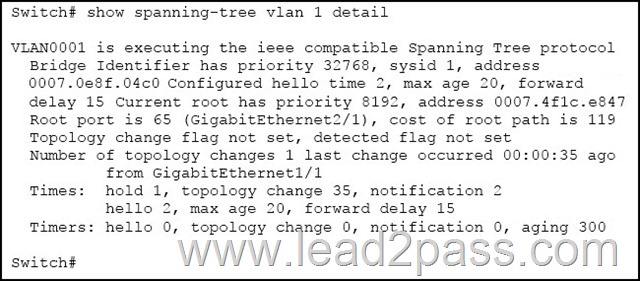
A. Setting the priority of this switch to 16384 for VLAN 1 would cause it to become the secondary root bridge.
B. IEEE 802.1s spanning tree is being used.
C. Spanning-tree PortFast should not be enabled on GigabitEthernet2/1.
D. The spanning-tree timers are not set to their default values.
Answer: C
QUESTION 209
Refer to the exhibit. EIGRP has been configured on all routers in this network.
Which EIGRP neighbor will R5 consider as the successor for network 192.168.1.0/24? 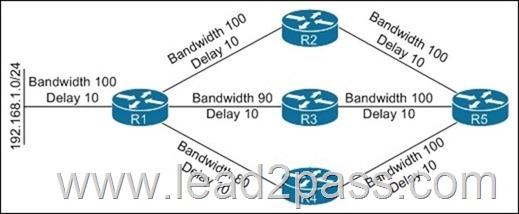
A. R3 will be the successor for 192.168.1.0/24.?
B. R4 will be the successor for 192.168.1.0/24.?
C. R2 will be the successor for 192.168.1.0/24.?
D. There is not enough information to determine which neighbor will be considered as successor.
E. R3 and R4 will both be a successor for 192.168.1.0/24.
Answer: C
QUESTION 210
Which statement is correct about IPv6 RA guard?
A. In host mode, all RA and router redirect messages are allowed on the port.
B. The RA guard feature is supported only in the egress direction; it is not supported in the ingress direction.
C. The RA guard feature is not supported on auxiliary VLANs and private VLANs.
D. The RA guard feature compares configuration information on the Layer 2 device with the information
in the received RA frame.
Answer: D
QUESTION 211
Refer to the exhibit. What is causing the error to occur on the MST switch? 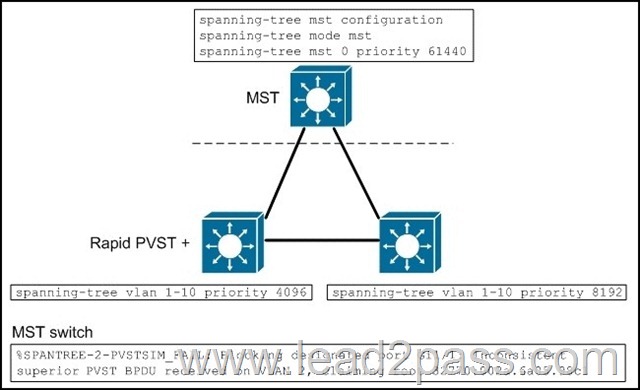
A. When a PVST+ switch is connected to an MST switch, the IST root (MST0) needs to be the root
for all PVST+ spanning trees.
B. When a PVST+ switch is connected to an MST switch, interaction between MST and PVST+ is
not supported
C. When a PVST+ switch is connected to an MST switch, root guard should be disabled on a
per-port basis.
D. When a PVST+ switch is connected to an MST switch, the PVST+ switch must be the root for
all MST instances.
Answer: A
QUESTION 212
Which two commands are required to enable multicast on a router, when it is known that the receivers use a specific functionality of IGMPv3? (Choose two.)
A. ip pim rp-address
B. ip pim ssm
C. ip pim sparse-mode
D. ip pim passive
Answer: BC
QUESTION 213
What are three causes for unicast flooding? (Choose three.)
A. asymmetric routing
B. duplex mismatch
C. unidirectional link
D. spanning-tree protocol topology changes
E. forwarding table overflow
F. hardware failure on a NIC
G. routing loop
Answer: ADE
QUESTION 214
Refer to the exhibit. Based on the configuration, what will be the final OSPFv3 neighborship state of R1 and R2? 
A. Both routers will be stuck in init state.
B. Both routers will be stuck in two-way state.
C. Both routers will be stuck in exstart/exchange state.
D. Both routers will be in full (DR or BDR) state.
Answer: C
QUESTION 215
Refer to the exhibit. R4 is configured as an OSPF stub. Which action must be taken to avoid R4 from learning OSPF type 3 LSA inter-area routes from 209.165.202.130? 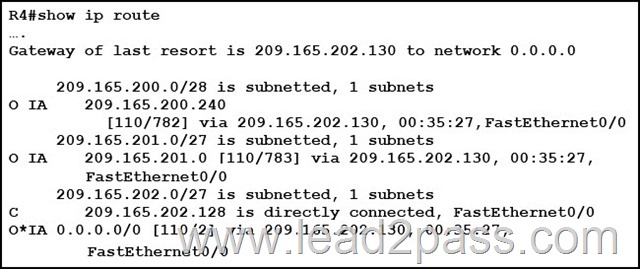
A. Disable sending summary LSAs by adding no-summary to the stub command on the ABR.
B. R4 must filter the incoming OSPF updates using route maps.
C. Disable sending summary LSAs by adding no-summary to the stub command on the ASBR.
D. Control of inter-area route propagation is best handled with EIGRP.
Answer: A
QUESTION 216
Which QoS mechanism will prevent a decrease in TCP performance?
A. Shaper
B. Policer
C. WRED
D. Rate-Limit
E. LLQ
F. Fair-Queue
Answer: C
QUESTION 217
What needs to be enabled for Unicast RPF?
A. BGP
B. OSPF
C. CEF
D. RIP
Answer: C
QUESTION 218
Refer to the exhibit. Which interface(s) will show ip rpf 1.1.1.2 indicate as RPF interface(s)? 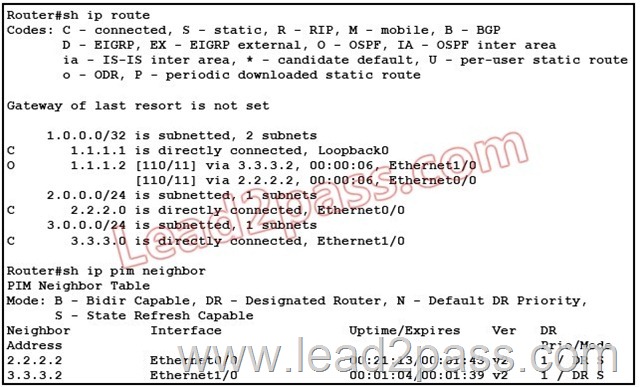
A. Ethernet 1/0
B. Ethernet 0/0
C. Both Ethernet 0/0 and Ethernet 1/0
D. RPF will fail
Answer: A
QUESTION 219
In order to maintain security, with which hop count are IPv6 neighbor discovery packets sent?
A. 0
B. 1
C. 255
D. 256
Answer: C
QUESTION 220
Which command will define a VRF with name ‘CCIE’ in IPv6?
A. ip vrf CCIE
B. ipv6 vrf CCIE
C. vrf definition CCIE
D. ipv6 vrf definition CCIE
Answer: C
Explanation:
Vrf definition CCIE creates a multiprotocol VRF for both IPv4 and IPv6
QUESTION 221
Refer to the exhibit. R4 is unable to establish an EIGRP adjacency with R3, the only other router on the Fa0/0 LAN segment, although it is able to ping R3. An EIGRP debug on R4 does not provide any clues. What might be the cause of the problem? 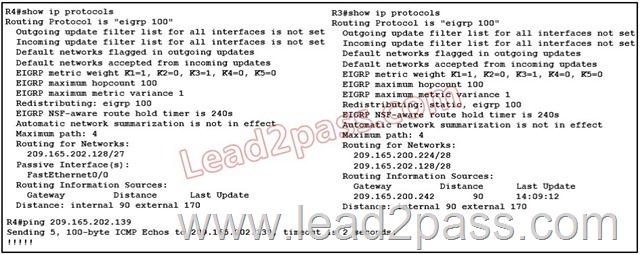
A. The passive interface has disabled the transmission of EIGRP multicast hello packets.
B. EIGRP on R4 should be routing to network 209.165.202.128/28.
C. The designated router/backup designated router (DR/BDR) selection requires that at least three
routers are on a LAN.
D. The routing metrics on R4 and R3 are different.
Answer: A
Explanation:
The passive-interface command disables the transmission and receipt of EIGRP hello packets on an interface. Unlike IGRP or RIP, EIGRP sends hello packets in order to form and sustain neighbor adjacencies. Without a neighbor adjacency, EIGRP cannot exchange routes with a neighbor. Therefore, the passive-interface command prevents the exchange of routes on the interface. Although EIGRP does not send or receive routing updates on an interface configured with the passive-interface command, it still includes the address of the interface in routing updates sent out of other non-passive interfaces.
QUESTION 222
Refer to the exhibit. The static route to 150.189.131.6 on R3 is intended to serve as the gateway of last resort for the EIGRP network. However, while R3 installs the gateway of last resort, its EIGRP neighbor R4 does not. What might explain the problem? 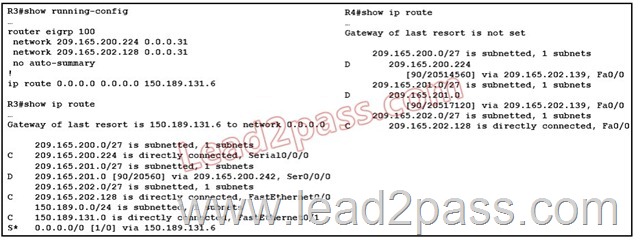
A. R3 is missing the global command ip default-network 150.189.131.6.
B. Autosummary must be enabled on R3 in order for default-routes to be propagated.
C. Default-networks must be configured individually on each EIGRP router.
D. The static route on R3 must be redistributed into EIGRP.
Answer: D
Explanation:
http://www.cisco.com/en/US/tech/tk365/technologies_tech_note09186a00800c2d96.shtml (see potential problems)
QUESTION 223
Refer to the exhibit. Which statement would explain why R4 and R3 are unable to build an EIGRP adjacency? 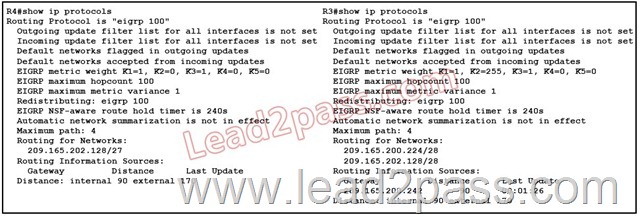
A. The network masks on R4 (209.165.202.128/27) and R3 (209.165.202.128/28) are different.
B. The local EIGRP process on R4 and R3 are the same (but they must be unique).
C. The routing metrics on R4 and R3 are different.
D. R4 is not routing for the network 209.165.200.224/28.
Answer: C
Explanation:
http://packetlife.net/blog/2010/aug/9/eigrp-feasible-successor-routes/
QUESTION 224
Refer to the exhibit. A tunnel is configured between R3 to R4 sourced with their loopback interfaces. The ip pim sparse-dense mode command is configured on the tunnel interfaces and multicast-routing is enabled on R3 and R4. The IP backbone is not configured for multicast routing. 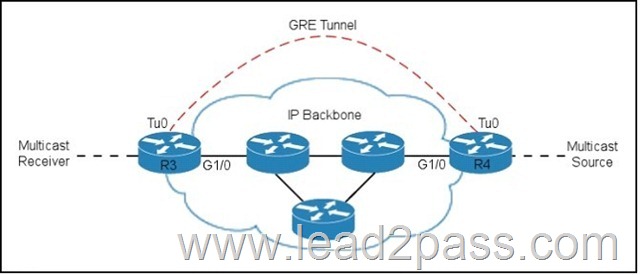
The RPF check has failed toward the multicast source.
Which two conditions could have caused the failure? (Choose two.)
A. The route back to the RP is through a different interface than tunnel 0.
B. The backbone devices can only route unicast traffic.
C. The route back to the RP is through the same tunnel interface.
D. A static route that points the RP to GigabitEthernet1/0 is configured.
Answer: AD
QUESTION 225
Which option is the default number of routes over which EIGRP can load balance?
A. 1
B. 4
C. 8
D. 16
Answer: B
Practise Lead2pass 400-101 braindumps and pass your exam easily. Lead2pass is number one company for real exam dumps. Download Lead2pass 400-101 exam questions and answers PDF file and prepare from our study material.
400-101 new questions on Google Drive: https://drive.google.com/open?id=0B3Syig5i8gpDU2RjeUlHTTZXb1U
2016 Cisco 400-101 exam dumps (All 1219 Q&As) from Lead2pass:
http://www.lead2pass.com/400-101.html [100% Exam Pass Guaranteed]
